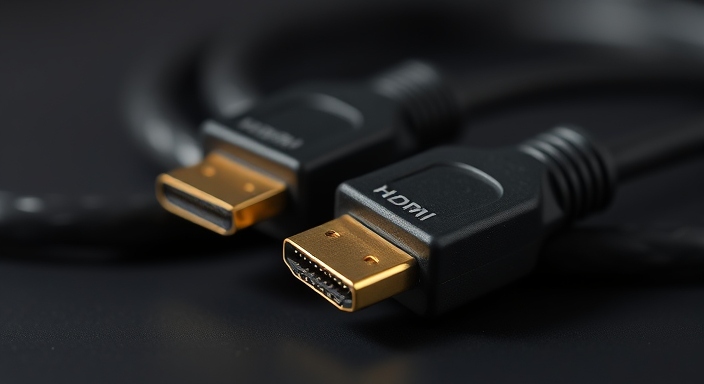Why HDMI Cables Still Matter in 2025
In 2025, as India embraces 8K televisions, high-frame-rate gaming, and cinematic home entertainment, one crucial component remains as relevant as ever — the HDMI cable. While Wi-Fi streaming and wireless casting continue to evolve, nothing beats the reliability, quality, and latency-free performance of an HDMI connection.
Whether you’re a gamer, a movie buff, or a professional working with projectors and displays, understanding HDMI cables is key to getting the best out of your device. In this guide, we explore how HDMI cables are the essential link for high-quality audio-visual experiences in 2025, and what you need to know before buying one.
What is an HDMI Cable?
HDMI (High-Definition Multimedia Interface) is a proprietary interface used to transmit high-definition audio and video signals between devices. An HDMI cable connects devices like:
-
Smart TVs
-
Gaming consoles (PlayStation 5, Xbox Series X)
-
Blu-ray players
-
Laptops
-
Soundbars
-
Home theatre systems
It supports uncompressed video and multi-channel audio — ensuring pristine quality.
HDMI Cable Evolution: What’s New in 2025?
| HDMI Version | Launch Year | Max Resolution | Max Refresh Rate | Key Feature |
|---|---|---|---|---|
| HDMI 1.4 | 2009 | 1080p | 60Hz | ARC |
| HDMI 2.0 | 2013 | 4K | 60Hz | HDR |
| HDMI 2.1 | 2017 | 8K | 120Hz | eARC, VRR |
| HDMI 2.1a | 2022+ | 10K | 120Hz+ | Source-Based Tone Mapping |
Pro Tip: Always look for HDMI 2.1 or higher in 2025 to future-proof your entertainment setup.
Top Features of a 2025 HDMI Cable
-
8K and 10K Video Support
Crisp visuals with ultra-high resolution and dynamic HDR. -
Enhanced Audio Return Channel (eARC)
Superior audio transfer to soundbars or AV receivers. -
Variable Refresh Rate (VRR)
A must for gamers to prevent screen tearing and lag. -
Auto Low Latency Mode (ALLM)
Automatically adjusts to the best latency setting for gaming or video. -
Dynamic HDR
Scene-by-scene optimization for better colour and contrast.
Why HDMI Cables are Still Relevant in India in 2025
✅ Growing 4K & 8K TV Adoption
India’s smart TV market is growing rapidly, with over 25 million 4K+ TVs sold in 2024 alone. HDMI ensures these TVs deliver what they promise.
✅ Gaming Revolution
With over 80 million Indian gamers, the demand for HDMI 2.1-enabled devices is booming. Modern consoles like PS5 and Xbox Series X require HDMI for full performance.
✅ Home Office & Hybrid Work
Professionals rely on HDMI to connect laptops to 4K monitors, projectors, and conferencing systems — especially in tier-2 and tier-3 cities.
✅ OTT & Streaming Boom
Platforms like Netflix, Hotstar, and Prime Video support Dolby Vision and 4K. HDMI cables help unlock full potential on big screens.
Types of HDMI Cables in 2025
| Type | Max Resolution | Use Case |
|---|---|---|
| Standard HDMI | 1080p | Basic TVs, Set-Top Boxes |
| High-Speed HDMI | 4K | Smart TVs, Media Players |
| Premium HDMI | 4K HDR | Gaming Consoles, Blu-rays |
| Ultra High-Speed HDMI | 8K/10K | Next-Gen TVs, VR, Home Theatre |
How to Choose the Right HDMI Cable
Here’s a step-by-step guide for Indian consumers in 2025:
🔍 Check the HDMI Version
-
Look for HDMI 2.1 or 2.1a if you own a gaming console or 8K TV.
💡 Consider the Cable Length
-
For home setups, 1.5 to 3 meters is ideal.
-
For projectors or large rooms, look for active optical HDMI cables.
🔌 Verify Certification
-
Buy certified cables with official HDMI labels. Avoid cheap knock-offs that promise 8K but deliver less.
💬 Read Reviews & Ratings
-
Platforms like Amazon India, Flipkart, and Reliance Digital showcase user feedback — use it to make smart decisions.
Real-World Example: Ramesh’s 8K Home Theatre Setup in Hyderabad
Ramesh, a tech-savvy professional in Hyderabad, recently upgraded to an 8K LG OLED TV and a Dolby Atmos soundbar. His first HDMI cable couldn’t transmit full Dolby Vision and caused audio sync issues. After switching to a certified Ultra High-Speed HDMI 2.1 cable, his setup now delivers flawless visuals and immersive sound. His advice: “Don’t compromise on the HDMI cable — it’s a small investment with huge returns.”
Common HDMI Cable Myths (Busted!)
❌ “All HDMI cables are the same.”
✅ Not true. Only certified HDMI 2.1 cables can handle full 8K at 60Hz or 4K at 120Hz.
❌ “Longer HDMI cables mean better performance.”
✅ Longer cables can degrade signals. For anything beyond 3m, opt for active HDMI cables.
❌ “HDMI is outdated; wireless is better.”
✅ Wireless streaming can compress signals. HDMI delivers uncompressed, zero-latency content.
Maintenance Tips for HDMI Cables
-
Avoid bending cables sharply.
-
Keep HDMI ports clean from dust.
-
Don’t unplug forcefully — it can damage the device port.
-
Label your cables if you have multiple connections.
Conclusion: Don’t Underestimate Your HDMI Cable in 2025
In the rapidly evolving digital entertainment landscape, the HDMI cable remains the backbone of high-quality, high-speed, and high-definition experiences. Whether you’re a gamer, a movie lover, or a professional, investing in the right HDMI cable is essential in 2025.
So next time you’re upgrading your TV or sound system, don’t forget this vital link. Choose quality. Choose performance. Choose the right HDMI cable.
Call to Action: Future-Proof Your Entertainment Today!
Looking for the best HDMI cable for your 8K TV or PS5 in India? Don’t wait. Browse certified HDMI 2.1 cables from trusted brands like Belkin, BlueRigger, AmazonBasics, and Zeskit on Amazon, Flipkart, or Croma.
👉 Upgrade now for a seamless, cinema-like experience at home!
